|


|

|
|
|
How to Install Power Steering
in a '65-'72 2WD Twin I-beam Pickup |
|
 |
When Ford started using the Twin I-Beam front
suspension in 1965 on all F-100s and F-250s, they also offered a power
steering option. Unfortunately, most buyers then didn't opt for this
'luxury'. Today, it's the burning question that every owner of a '67-'72
pickup wants to know: "How do I install power steering into my old
truck?" It seems to be one of the most frequently-asked questions in the
'67-'72 Ford pickup forums. Well, wonder no more...follow along as we
investigate what you'll have to do to upgrade from 'Armstrong' steering
to power steering using readily-available factory parts from your local
salvage yard. The information contained here also pertains to '65-'66
Ford pickups...as long as it has the Twin I-beam suspension.
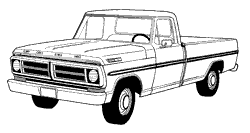 NOTE: Since four-wheel-drive steering boxes are located in front of the
axle and two-wheel drive boxes behind, the mechanical parts needed to
convert to power steering are different; therefore, the details in this
article are meant for conversion on two-wheel-drive pickups only.
NOTE: Since four-wheel-drive steering boxes are located in front of the
axle and two-wheel drive boxes behind, the mechanical parts needed to
convert to power steering are different; therefore, the details in this
article are meant for conversion on two-wheel-drive pickups only.
For the remainder of this article, 'PS' refers to 'power steering'.
Basically, here's all you need to do: find
yourself a donor truck in the local U-Pull-It yard which is equipped
with PS and swipe the following parts:
-
'67-'79
steering box
-
'67-'72
steering column ('73-'79 columns can be used with modifications...see
below)
-
PS pump and
bracket appropriate for your engine
-
PS column firewall mounting bracket and rubber boot
-
left-side
engine perch (depending on application...see below)
-
steering
linkage (everything between the steering box and the wheel spindle
steering arm)
...and then just bolt them on and go. However,
there are a few things you need to be made aware of, so let's expand on
the above listing and discuss why you'll need certain items and some
possible complications you might encounter.
Steering box: First of all, Ford pickups were produced with two
style of PS boxes: the Saginaw (commonly known as the Ford box, and what
you're mostly likely to find in the salvage lot) and the Bendix.
-
The Bendix
box
has almost the same dimensions as the manual steering box, so it is a direct
replacement. Usually, no alterations of the steering column or frame are
necessary with this box, though in some cases, the slightly-longer
steering column shaft will push the steering wheel out a tad, creating a
gap between the end of the column and the steering wheel. If this
happens, you might be able to adjust the column mounting to take up the
slack...but in some cases there will be insufficient adjustment
available.
It was the only PS box used in '65 and '66,
whether for auto or manual shifter columns, and was also used in the '67-'68 trucks
and '69 trucks up to serial #D96,000, mainly
for automatics and 'three-on-the-tree' shifters. (F350s trucks could not
get power steering until 1969 after serial #D96,000, so they were all
equipped with the Ford/Saginaw steering box.) However, it's not going to
be an easy task locating one in a salvage yard. They are available
aftermarket, if you have the money to spend, but they aren't cheap. The Bendix box is not as hardy as the Saginaw, tends to leak and generates
more heat, requiring a good cooler for longer service, which is why Ford
replaced these with the Saginaw unit. A small
transmission cooler mounted in front of the radiator has been suggested
as the best course to control heat build-up. If you decide to use the Bendix box and are able to
find one, all you need to convert your truck to power steering is the
steering box, pump, brackets and belts. Be aware that if you use the
Bendix box in your FE (360/390) truck, there will be some header
clearance issues (that is, they'll be very tight!) Therefore, if you're wanting
to add headers sometime in the future, it would be best to go with the
Saginaw box.
-
The Saginaw
box began to be phased in by Ford in '68 to replace the Bendix box
and was used almost exclusively by 1969. It is more readily available
and stronger...but it's also about 2 inches longer than the manual or
Bendix PS boxes...which means if you attempt to bolt a manual steering
column up to a Saginaw box, it will end up extending into the cab an
additional 2 inches. It would work, but it would look funny, it would
require some modifications to the column mounting point at the
dash...and it would be downright dangerous (in my opinion), being that
much closer to your body. In case of an accident, you want to be as far
away from the steering wheel as possible. Remember, these trucks were
not equipped with airbags! While it's possible to make it work, it's
HIGHLY recommended that you do not try this.
|

Here is a (greasy) side-by-side comparison of the two different
style of power steering boxes used by Ford. The difference is
installed height is obvious. |

The Bendix box and
the Ford/Saginaw box
CLICK
IMAGES
TO ENLARGE |
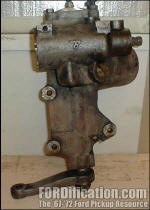 The
Bendix box. Note the large "B" script along the side, making
identifying easy. The
Bendix box. Note the large "B" script along the side, making
identifying easy. |
Steering column: If you decide to 'upgrade' to the Saginaw box, then this info
pertains you to. Since the Saginaw box is about two inches longer than a
manual-steering (or Bendix) box, your existing column will not work as
is. Obviously, the easiest course of action would be to simply find a
donor truck of approximately the same year as your own and swap the
steering column and box from it. If you don't have access to an original
PS column (or you simply want to keep your existing column), you can shorten the column's main shaft two inches to compensate for the
additional length of the steering box, and section the
main column housing and shift tube, and bend the shifter linkage arm (at
the base of the column). While this isn't a particularly difficult
procedure, it does require disassembly of the steering column, as well
as some cutting and welding. For more detailed information on how to do
this, see "How to Shorten Your
Manual-Steering Column".
You can also use a
readily-available PS column from a '73-'79 pickup. The physical dimensions are
the same as the '69-'72 PS versions...just keep in mind that the wiring connection for the horn,
turn signals, etc. will be different, and will require some minor
rewiring to get hooked up. Most of the wires are the same color,
allowing an almost quick and painless swap. Turn signal switches from
various years can be interchanged by substituting the pin positions in
the harness connector.
If you decide to go this route, you could even add a tilt-column, although
tilt-columns for manual-shift applications are very hard to find initially
and parts aren't as readily available. Factory tilt columns were available
only in
'78 and '79 and appear fairly regularly on E-bay for $100-$300.
|
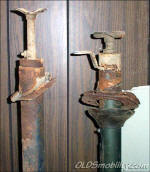 |
Left: '68 4-spd. manual column, can be used with
Bendix PS box or the main shaft will have to be
shortened to use Saginaw/Ford PS box. However, the
column housing is already at the desired length, so you
could easily swap the shorter PS shaft into this column
with no other modifications necessary.
Right:
'70 auto column with Saginaw/Ford PS box.
(Click to enlarge) |
|

If swapping steering shafts, keep in mind that the
'71-'72 shafts are slightly longer on the cab end which
won't allow mounting a '67-'70 steering wheel unless you
grind off the excess material. |
If you go with the Bendix box, you might get lucky and
be able to re-use your existing column....but don't bet
on it. It's a very common
misconception that Bendix steering boxes use standard
columns...but this is not true. If you look it up in the
parts books you'll see there are three lengths of column
shafts
- Manual steering has a center shaft that is
35-5/8" ('67-'70) or 36-1/8" ('71-'72)
- Bendix is 34-15/16"
- Saginaw is 32-7/8" ('67-'70) or 33-3/8 ('71-'72)
(Note: the extra length of the '71-'72 is really
at the top above the threads, not in the length inside the tube. See
photo at left.) |
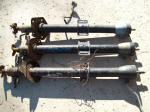 |
At left is a picture of a '68 3-speed
manual-steering column, a '72 3-speed power-steering column and a
'73-'77 3-speed power-steering column ('78-'79 are different and have
the big upper housings). The difference from power to manual is obvious
because of the length, the differences between '72 and '73 are subtle
but the most obvious are the '72 does not have an emergency flasher
switch on the column and the firewall seal is a metal plate with a piece
of rubber stapled to it while the later one is more like a plate with
rubber molded to it. |
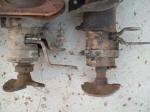 |
On the left is a power-steering 3-speed column, on the
right is a manual-steering 3-speed column. Note the difference in the
shifting arms and the location they exit the column. The PS unit has the
arms exiting closer to the end of the tube. Simply trying to slide a
manual-steering column up farther into the cab to compensate for the
difference in length will cause it to bind on the firewall-mounting
bracket. |
|
Another thing to keep in mind is the column wiring for
the '67-'69 trucks differed from the '70-'72 columns at
the connector. All '67-'72 columns have 8 wires going to
them. However, the '67-'69 columns have two connectors
(one connector has 6 wires and the other has 2) whereas
the later columns incorporated all 8 wires into one
connector...but the wires themselves are the same. If
you use a '70-'72 column on a '67-'69 (or vice versa),
you could easily splice in the correct harness
connectors, if you can get a couple inches of the wiring
on the end from your donor truck's main wiring harness.
The best idea would be to simply move the pin connectors
from one style of harness connector over to the other
style, depending on the year of your truck, so that
it'll plug right in.
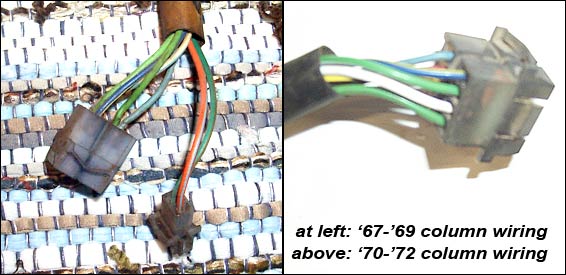 |
|
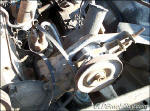
This newer-style mid-'80s PS pump for the Ford 300 I6 would be a
direct bolt-on for the earlier 240s. Make sure you get the mounting
bracket and pulleys.
(Click to enlarge) |
Power steering pump: Since PS was available with every engine
option, finding a pump with the necessary brackets
shouldn't be a problem. Just get a pump and bracket from
any '67-'79 engine similar to yours, along with the
hoses. (New hoses are recommended but not required,
providing the old lines are in good shape.) You can even
use Ford pumps up through the mid-'80s as long as you
have the correct bracket and pulley. However, you will
have to get the new-style hose.
The FE-engine pump brackets can be used from any
FE engine, car or truck. Be sure to get matching
harmonic balancer and pulley, as there are two different
styles: a 3-hole and a 4-hole. Either will work, just
make sure they're a matched set. With an A/C-equipped
truck you'll need a 3-groove bottom pulley...engines
without A/C need a 2-groove pulley. Also, the early FE
pump brackets are a 3-piece set, while the later
versions are a 2-piece. As long as you get a matched
set, either will work fine, but they do not interchange
with each other.
Left-side engine perch (FE & Saginaw box only): If you have an
FE engine (352/360/390/428) and opt for the Saginaw PS box, be aware the
driver's-side engine perch on '65-'69 trucks is shaped a little differently.
It will clear the manual steering box and the Bendix box, but it had to
be redesigned for the '70-up trucks with the Saginaw box. For a true bolt-in, you'll need to
get the perch from a '70-'76 FE-equipped pickup. (The
'70-'76 FE-equipped pickups already have the correct piece in place,
regardless of manual or power steering or engine size.) The
required perch slants forward a little (toward the radiator) to make
room for the Saginaw box. If you look at your frame, you will see a hole
just forward of the existing perch. This is one of the holes your new
perch will bolt to. The other is covered by the existing perch, but it
is up under there, so if you're handy with a grinder, you can easily
modify your existing perch for clearance. (You can readily tell when you
bolt the box to the frame if there is any interference.)
NOTE: Since
the Saginaw box was used exclusively by mid-'69 when the 302ci engine
option became available, the left 302 perch is already angled correctly
to clear the box. Therefore, there is no difference between MS and PS
perches used on small-blocks...they're all the same. |
|
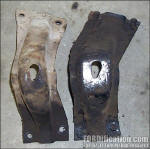
Here is a side-by-side comparison of the two different styles of FE
engine stands - early vs. late. The early version is on the left vs.
the later one on the right. You can see the top section
of the PS stand is canted a bit more to the right (towards the front
of the vehicle) to clear the Saginaw-style PS pump. If you're using
a Bendix box, you can use your existing perch. |
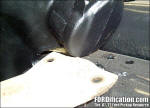 |
Shown
here is the early engine perch next to the Saginaw PS box.
You can see there's not enough clearance between the box and the
frame rail to use. You could either notch this for clearance or find
the correct later stand which is offset towards the front of the truck
for clearance. |
|
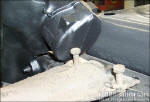 |
Here is
the later ('70-up) FE engine stand for use with a Saginaw box. The
upper connection uses a different set of holes, while the bottom
remains in the same place. |
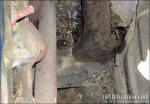 |
LEFT:
One of my parts trucks had the notched engine perch done by a
previous owner. The Saginaw box cleared this by about 1/8" all the
way around, so this would seem to be about the amount of material
you'd need to remove from a stock manual steering or Bendix PS FE
(360/390) perch.
RIGHT: Here you can see the correct offset bracket installed. |
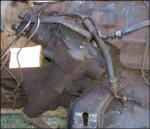 |
|
Other notes:
|
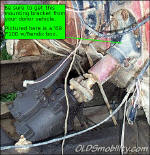
This is the column-to-firewall bracket needed when switching to a
Saginaw box.
(Click to enlarge) |
2WD trucks with FE motors have an oil filter housing which holds the
filter horizontally. A car engine will have a filter housing which
mounts the filter in a vertical position. If you've got a car
engine in your truck, you'll have to use a truck-type filter mount to
enable you to tighten the power steering pump and avoid hitting the
front crossmember. (4WD trucks use the vertical adapter because the
front crossmember is in a different location, plus a horizontal adapter
would hit the steering shaft.)
The PS column firewall mounting bracket used on Saginaw-equipped systems
IS different as compared to the manual steering (or Bendix PS) bracket.
The correct piece should even say 'POWER STEERING' right on the part. It
will hold the column up about an inch higher in this spot vs. the
manual-steering bracket, due to the difference in angle necessary to
compensate for the additional length of
the Saginaw box. Be sure you have the right one to avoid having to make
a lot of modifications to get a manual steering column bracket to fit.
The picture to the right shows the bracket, though this particular one is
of a Bendix-box setup, which is the same as the manual steering bracket,
so in this case the bracket wouldn't need to be obtained from a donor
vehicle since it's identical to the PS version. The picture is for
visual reference only. The different brackets are pictured below:
|

Left: Manual steering & Bendix box PS
Right: Saginaw box power steering |

Background:
Manual
steering & Bendix box PS
Foreground: Saginaw box power steering |

Power steering bracket is marked as such |
|
 |

Want to link to
this site? Please save this banner to your hard drive to place on your
webpage.
The correct link to use is
http://www.fordification.com
|